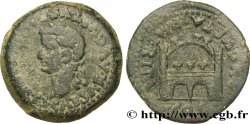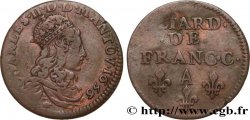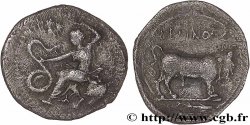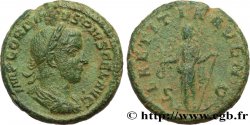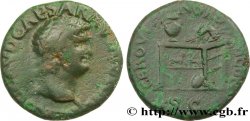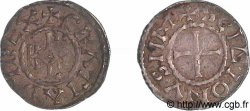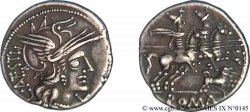brm_854477 - TIBERIUS Denier
Not available.
Item sold on our e-shop (2024)
Price : 280.00 €
Item sold on our e-shop (2024)
Price : 280.00 €
Type : Denier
Date: c. 33-37
Mint name / Town : Lyon
Metal : silver
Millesimal fineness : 950 ‰
Diameter : 19 mm
Orientation dies : 6 h.
Weight : 3,66 g.
Coments on the condition:
Flan légèrement décentré. Joli portrait. Usure régulière. Patine grise
Catalogue references :
Obverse
Obverse legend : TI CAESAR DIVI - AVG F AVGVSTVS.
Obverse description : Tête laurée de Tibère à droite (O*).
Obverse translation : “Tiberius Cæsar Divi Augusti Filius Augustus”, (Tibère César fils du divin Auguste, auguste).
Reverse
Reverse legend : PONTIF - MAXIM.
Reverse description : Pax (la Paix) ou Livie assise à droite sur un siège décoré, tenant une branche d'olivier de la main gauche et de la droite un long sceptre.
Reverse translation : “Pontifex Maximus”, (Grand pontife).
Commentary
Comme pour le denier d'Auguste, cette pièce appartient à l'atelier impérial de Lyon et ce type de denier a circulé pendant pratiquement un siècle. Il se rencontre très souvent avec des monnaies gauloises de la phase terminale dans les fouilles archéologiques. C’est la monnaie romaine la plus courante en Gaule pour les Julio-Claudiens. La cinquième émission se caractérise par un socle représenté par une seule ligne et les pieds du siège sont ornés de fleurons ; les pieds de Livie reposent sur un tabouret, invisible sur notre exemplaire ; au droit, les rubans de la couronne de type 3 retombent en petites ondulations, le portrait reste réaliste.
As with the Augustus denarius, this piece belongs to the imperial workshop of Lyon and this type of denarius circulated for almost a century. It is very often encountered with Gallic coins from the terminal phase in archaeological excavations. It is the most common Roman coin in Gaul for the Julio-Claudians. The fifth issue is characterized by a base represented by a single line and the legs of the seat are decorated with fleurons; Livia's feet rest on a stool, invisible on our copy; on the right, the ribbons of the type 3 crown fall in small undulations, the portrait remains realistic
As with the Augustus denarius, this piece belongs to the imperial workshop of Lyon and this type of denarius circulated for almost a century. It is very often encountered with Gallic coins from the terminal phase in archaeological excavations. It is the most common Roman coin in Gaul for the Julio-Claudians. The fifth issue is characterized by a base represented by a single line and the legs of the seat are decorated with fleurons; Livia's feet rest on a stool, invisible on our copy; on the right, the ribbons of the type 3 crown fall in small undulations, the portrait remains realistic








 Report a mistake
Report a mistake Print the page
Print the page Share my selection
Share my selection Ask a question
Ask a question Consign / sell
Consign / sell
 Full data
Full data
